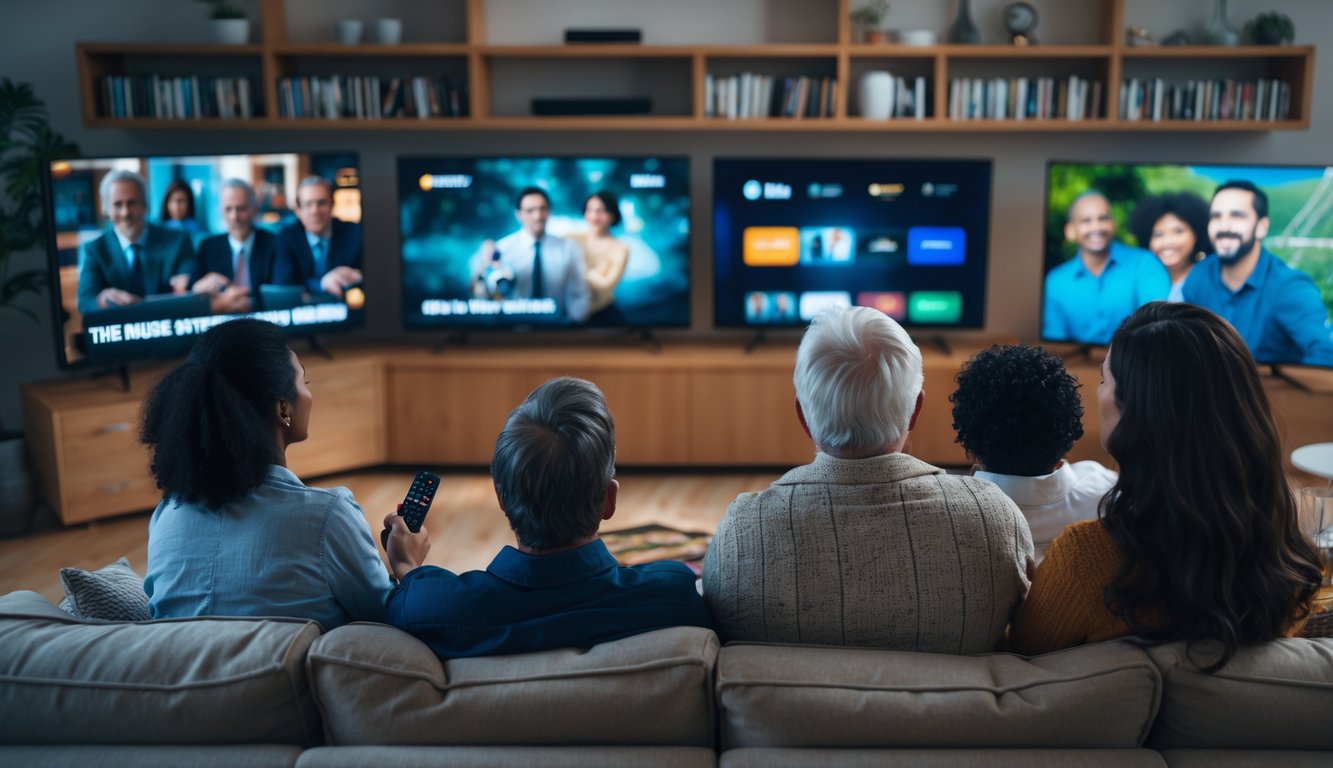
Future Outlook: What’s Next for TV Genres and Audiences?
It’s 2025, and if you blink, you’ll miss whatever wild pivot media execs are selling this week: AI-powered shifts, micro-communities yelling for their own shows, and everyone pretending pandemic leftovers aren’t still clogging up the home screen.
Adapting Content Creation for Evolving Audiences
The race is on: creators desperately try to engineer the next big genre while staring at stale engagement graphs. Studios toss real money at docuseries because apparently Gen Z hates sitcoms, but here I am, rewatching old ones on Hulu with everyone else. Maybe you’ve seen the numbers? Customization is king. This EY insight says niche audiences have all the power now.
Algorithms push producers to greenlight pilots that would’ve never survived a decade ago. Streaming platforms don’t just compete—they accidentally invent new sub-genres, then panic and go all-in on ad-supported models everyone hated last year. I once watched a marketing exec literally grimace while explaining “micro-moments of engagement.” I still don’t know what that means.
A showrunner told me, “Writers barely finish a pitch and AI spits out twenty versions—pick the one least likely to tank your review.” I roll my eyes, but hey, flexibility isn’t nothing. Networks want adaptable, real-time data on viewers and sometimes just gamble anyway.
Long-Term Impacts of the Covid-19 Pandemic
Nobody wants to admit they miss lockdown TV marathons, but the numbers don’t lie. Remote production eats up budgets, hybrid teams slow everything down, and audience attention’s scattered across five screens. Nielsen said TV viewership soared 60% during peak lockdowns, but then everyone retreated to comfort food genres—sitcoms, cooking shows, weirdly specific local news.
Advertisers flip-flopped constantly. Remember all those canceled shoots and awkward return-to-set interviews? My director friend complains his crew’s remote now except for live shoots. Platforms hoard rights for “flexible licensing”—basically legal hoarding. It’s way messier than the industry admits.
What still throws me: pandemic habits linger, but not for the reasons LinkedIn keeps posting about. Pandemic programming fatigue is real. I’ve got emails from writers who pitched lockdown thrillers and got ghosted—or got a nice rejection blaming “audience mood metrics.” You can’t measure mood swings, no matter how many dashboards you check.
The Role of Community and Real-Time Engagement
Discord servers, Twitch raids, live “watch parties”—I can barely keep up, and apparently neither can Netflix’s engineers. Everyone wants a magic formula to make viewers feel less alone, but not, you know, forced into Reddit debates at 2 a.m. This trend analysis says community-based media keeps people watching longer, but good luck explaining that to a shareholder who’s never joined a group chat.
I keep thinking about how “live” still matters. Sports, elections, finales—everyone crowds into a virtual living room, then it’s over and the memes start. Interactive formats? Some totally flop (I’m still bitter about that one adventure show with the audience voting), but the industry just keeps fumbling forward. An exec told me, “We’re improvising half the tech stack as we go.” You get surprises: micro-genres born from group rewatches, breakout stars from niche subreddits, shoestring-budget shows launching merch because a Discord server demanded it.
No formula. Sometimes a chat explodes over a cat on screen, sometimes it’s dead air. Only guarantee? Next year, someone will pretend “community strategy” was their plan all along.
Frequently Asked Questions
Trying to figure out why everyone’s obsessed with Nordic crime dramas now, or why reality romance shows just won’t die? Meanwhile, execs throw money at genres you’d never expect—audience habits bend, snap, double down, and genre investments nudge them along.
How does financing different TV genres influence viewer trends?
Last I checked, dumping money into sci-fi and fantasy made streaming sign-ups spike. Forrester said “original genre hits” led to 13% more platform loyalty. On the flip side, fund prestige drama and suddenly everyone’s talking about symbolism at work instead of, I don’t know, the weather. Genre funding changes what people talk about, even if the office snack machine is still broken.
What impact does genre diversification have on television audiences?
Remember when TV was all cop shows and sitcoms? Now, put money into animation or international thrillers and suddenly your friends are quoting Turkish dramas they can’t pronounce. This audience study shows viewership spikes all over the map. One friend cheers for quiz show winners in three languages now. TV diets are weird.
In what ways do TV show genres contribute to cultural shifts?
One week, everyone’s talking like they’re on a spaceship; next, true crime podcasts spark dinner debates about the justice system (“Where’s the transcript?” someone asks). A professor I trust says genre surges don’t just reflect culture—they bulldoze new trends, from school debates to your aunt’s weird memes on Facebook. But cowboy hats? Still waiting for that comeback.
Can investment in certain genres reshape television viewing habits?
Honestly, I don’t even know what counts as “reshaping” anymore. Throw some money at a sci-fi show, and suddenly my brother—who claims he hates TV—has opinions about space politics. My neighbor’s TV? That thing glows like a radioactive potato every night, and she just shrugs, blaming “all these weird new genres.” I mean, have you seen the stats on streaming vs. traditional TV? People pretend they’re above it, but then why are we all zombies at work after binging some Danish crime thing? No one’s honest about it. I’m not even sure I am.
How does audience preference drive the future of TV genre production?
Producers act like they can read my mind, which is both creepy and, I guess, kind of true. They see thrillers spike on some chart and, boom, two more shows drop before I can finish my coffee. My watchlist? Not even mine anymore; it’s basically a lab rat maze for their experiments. I stumbled on this stat—apparently 72% of adults still use regular TV every month (source). That’s wild. But, honestly, I doubt it’ll last. Investment just steamrolls whatever’s left of “tradition.” Am I supposed to be nostalgic? I’m not sure.
What role does genre popularity play in the evolution of television content?
Genre popularity? Honestly, it’s like watching a bunch of executives panic-buying whatever’s trending on Twitter. One “cozy mystery” blows up—suddenly, every network’s convinced we’re all dying for more tea-sipping detectives. I heard some producer mutter, “We just follow the heat.” Not exactly confidence-inspiring, right? Meanwhile, there’s a flood of the same stuff, and all the weird or brilliant shows? Yeah, good luck seeing those get made. And then there’s my uncle—he’s still glued to 1980s game show reruns every night. No algorithm or trend forecast has ever budged him. So, does popularity really shape content, or is it just noise? I honestly can’t tell anymore.



